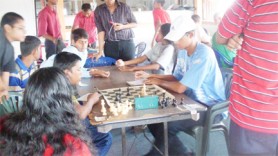-Ralph Waldo Emerson.
Just so in chess. The game clearly shows us the power of ‘why.’ Kasparov has taught us that every move has a consequence. The player who wins, he argues, is the player who questions his moves consistently.

The game against Taffin Khan, however, was different. I knew ‘why.’ As White I knew exactly
where each of my pieces should go for maximum penetration of the enemy camp in the middle game. It is not surprising that White smashed the defences surrounding Black’s king and won handsomely. If I am to refer to Kasparov once more, who incidentally trains Norwegian teenage sensation Magnus Carlsen, this is what he has to say: Before each decision, we should ask, “Why this move? What am I trying to achieve and how does this move help me to achieve it?”
We are beginning to see some talent on display among the juniors in tournaments. At the recent Trophy Stall Tournament Raan Motilall from West Demerara Secondary, captured the special prize for ‘Most Improved Junior.’ He won the tournament ahead of the more experienced Saeed Ali, Khalid Gajraj, Rashad Hussein and his brother from Saint’s, Ron Motilall.

Taffin Khan is improving steadily and should be commended for beating the national champion. He moved from among the juniors last year and decided to play with the seniors. After one year, he has emerged victorious in the first major tournament of 2010, which included the national champion. According to Loris Nathoo, the juniors “have begun to catch up with us.” This is a great sign for the development and vision for chess in Guyana. The future of chess is playing among us.
For the DDL’s Topco Juice Mashramani Chess Tournament which begins in two weeks, I urge the juniors to constantly ask the question as they play each game: ‘Why?’ It is the question that separates visionaries from functionaries, great strategists from mere tacticians, and over the chess board, winners from losers. And lastly juniors, never underestimate your opponent’s move. In almost every instance, there is a motive behind it. Check it out. And remember, never play a move hoping that your opponent would not ‘see it.’
Carlsen v Caruana
Teenage grandmaster Magnus Carlsen defeated a world class field to emerge victorious in the exclusive Wijk aan Zee 2010 chess tournament. The 19-year-old Norwegian amassed a total of 8.5 points from thirteen games, losing one game in the process to former world champion Vladimir Kramnik. Alexei Shirov who led in the early stages of the tournament, placed third, and world champion Vishy Anand, fourth. Chess experts have said that Carlsen’s FIDE ranking in the next rating list may well be the second highest in the history of chess, second only to Garry Kasparov. Kasparov is Carlsen’s personal trainer. Here is Carlsen’s last round game with Italian grandmaster Fabiano Caruana.
Carlsen, M (2810) – Caruana, F (2675) Corus A Wijk aan Zee NED (13), 31.1.2010
1.e4 e5 2.Nf3 Nc6 3.Bb5 a6 4.Ba4 Nf6 5.d3 d6 6.c3 g6 7.Nbd2 Bg7 8.Nf1 0–0 9.Bg5 d5 10.Qe2 Qd6 11.Bxf6 Bxf6 12.Ne3 Ne7 13.Bb3 c6 14.h4 Be6 15.Ng5 Bd7 16.Rd1 Rad8 17.Qf3 h618.Nc4 dxc4 19.dxc4 Nd5 20.Nh3 h5 21.Qg3 Bg4 22.Rd2 Bxh4 23.Qxh4 Qf6 24.Qxf6 Nxf6 25.Ng5 c5 26.f3 Bc8 27.Ba4 Kg7 28.Rxd8 Rxd8 29.b4 Rd3 30.bxc5 Rxc3 31.Kd2 Rxc4 32.Bb3 Rxc5 33.Nxf7 a5 34.Rc1 Rxc1 35.Kxc1 a4 36.Bc4 b5 37.Nd6 bxc4 38.Nxc8 h4 39.Nb6 Nh5 40.Nxc4 Kf6 41.Kd2 Nf4 42.Ke3 Nxg2+ 43.Kf2 Nf4 44.Nb2 a3 45.Nc4 Nd3+ 46.Kg2
46…Kg5. Taking off the a2-pawn by 46…Nb4 47.Nxa3 Nxa2 would have left a 3 v 2 ending with all pawns on the same side. The presence of knights should give better winning chances than normal in such positions, but whether it is enough is not clear. 47.Nxa3 Kf4 48.Nc2 Nb2 49.Nb4 h3+ 50.Kxh3 Kxf3 51.Kh4 Kf4 52.Nd5+ Kxe4 53.Ne7 Kf3 54.Nxg6 e4 55.Ne5+ Kf4 56.Ng4 Na4 Draw. ½–½.




